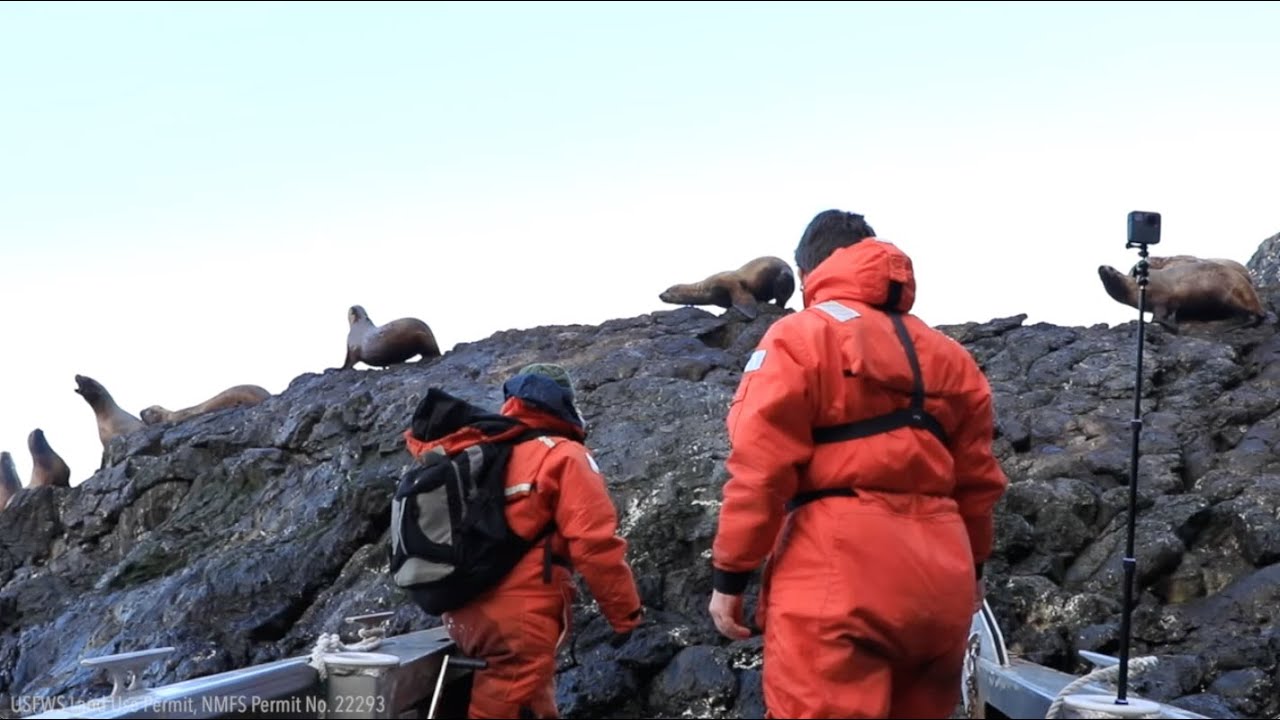*****
Summary of Transcript:
The video features a team that works to monitor seal populations living on islands near the ocean. They use a boat to travel to the islands and climb over steep, uneven rocks to reach the seals. They use cameras, including remote video systems, to monitor the seals and their habitats. During the winter, they collect scat to learn about the seals’ diet and survival rates, and they are currently studying changes in their diet and reproductive rates in recent years.
*****
Summary of Description:
The video showcases the work of wildlife biologists in Alaska and the view of the Alaskan wilderness. ASLC scientists working on the Chiswell Island Steller sea lion project conduct remote video monitoring and fieldwork that requires specific permits.
*****
As a Wildlife Biologist in Alaska: A First-Hand View
Alaska’s wilderness has many unique animals, including the Steller sea lion. These majestic creatures are a marvel to behold and play an important role in the ecosystem. Studying them is a challenge, but it’s a job that Wildlife Biologists in Alaska take very seriously. In this article, we’ll take a closer look at the work of these dedicated scientists and get a glimpse into the life of a wildlife biologist in Alaska.
Behind the Scenes: Remote Video Monitoring
One of the key tools in a wildlife biologist’s arsenal is remote video monitoring. This allows scientists to observe animals in their natural habitat without disturbing them. Researchers at the Alaska SeaLife Center (ASLC) use this technology to study Steller sea lions on Chiswell Island. This remote monitoring is crucial in understanding these animals’ behavior, from their diet to their social interactions.
In the Field: Setting Up the Research
Fieldwork is a major component of wildlife biology research in Alaska. It’s where scientists get up close and personal with their subjects, and it’s where they gather the data they need to answer important questions. But it’s also a challenging environment, with unpredictable weather, dangerous terrain, and wildlife that can be both dangerous and elusive.
For the Steller sea lion project, ASLC scientists set up a base camp on Chiswell Island. This involves acquiring permits, transporting gear and supplies, and setting up camp in a safe location near the study area. Once the base camp is established, the real work begins.
Living in the Field: The Challenges of Remote Research
Alaska is unforgiving, and living in the field can be challenging. Wildlife Biologists in Alaska may spend weeks or even months in remote locations, far from the comforts of home. They must be self-sufficient, adapt quickly to changing conditions, and work as a team to get the job done.
Living in the field means living in close quarters with your fellow researchers. It also means dealing with limited supplies and resources, including food, water, and electricity. But it’s all worth studying these amazing creatures up close and contributing to their conservation.
Discoveries in the Field: The Rewards of Research
Wildlife biology research aims to understand better the natural world and how to protect it. For the ASLC scientists studying Steller sea lions on Chiswell Island, their work has led to some exciting discoveries. They have observed the sea lions’ behavior in ways never before possible, and thy gathered important data on their diet, health, and population dynamics.
This research has already led to changes in how Steller sea lions are managed in Alaska. By understanding their behavior and needs, scientists can help ensure these animals continue to thrive in their natural habitat.
Conclusion
Being a Wildlife Biologist in Alaska is not an easy job, but it’s incredibly rewarding. From remote video monitoring to fieldwork to living in the challenging Alaskan wilderness, these dedicated scientists are making a difference. By studying and understanding Alaska’s unique wildlife, they are helping to protect it for generations to cyoWatching this video is a great first step if you ever wondered what it’s like to be a wildlife biologist, wat**
Source Description
If you’ve ever wanted a first-hand view of what it’s like to be a wildlife biologist in Alaska (and to see some incredible Alaskan views!), don’t miss this video!
In addition to the remote video monitoring work, the ASLC scientists working on the Chiswell Island Steller sea lion project also do some truly incredible fieldwork, all of which require specific permits.


